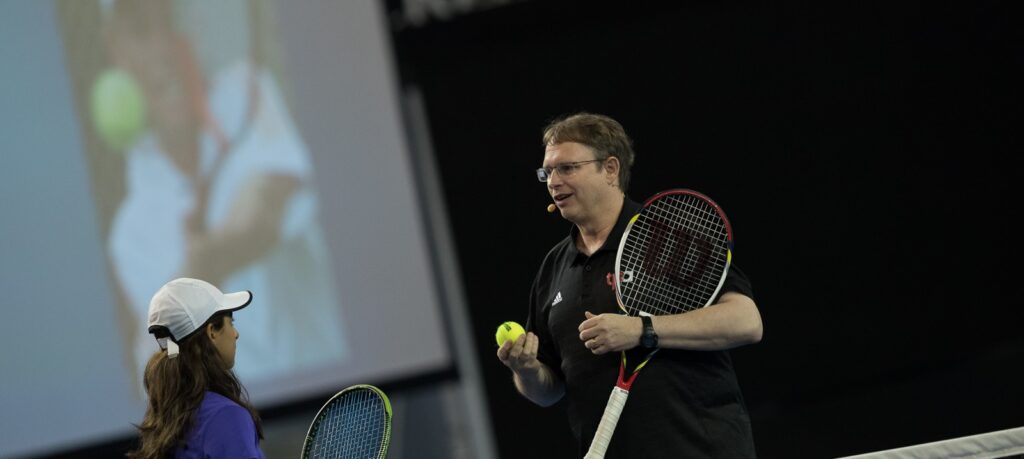

Tactics are one of the 4 Performance Factors that are critical in player development.
- Psychological
- Physical
- Tactical
- Technical
When dealing with tactics, coaches need to understand a few essential concepts:
STRATEGY VS. TACTICS
‘Strategy’ and ‘tactics’ often get confused by coaches. Strategy is a planning process done prior to performance. Strategy is your overall game plan which could include elements from all 4 performance factors (psychological, physical, tactical, technical).
Tactics occur during performance and require decision-making. Tactics are the specific actions you take to implement your strategy in situations (which may require adaptation).
We can define tactics as:
‘The intention, decisions and actions of players to gain advantage over an opponent.’
PROBLEM-SOLVING
Tennis is a ‘game-sport’. All games require problem-solving. This includes the problems opponents throw at you and the ones you create for them. In games (whether chess, hockey or tennis), problems are mainly expressed through tactics (e.g., solving the problem of how to deal with an opponent’s powerful serve. Solving the problem of how to pick on an opponent’s weakness, etc.).
Tactics are situational and require quick and effective decision-making to select the best solution to the problems they encounter during play.
The core tactical decision in every situation is whether you are in Neutral, Offence, or Defence (N.O.D.). These are called the ‘Phases of Play.’
Phases of Play are what I call ‘Micro-tactics’ as they happen within the cycle of an individual shot. (for an article on the Shot Cycle, click here)
PHASES OF PLAY: DEFINITION
A Phase of Play is the relationship between the perceived difficulty of the ball received and the risk adopted in sending it.
NEUTRAL: A player is in a neutral situation when they perceive a moderate reception challenge and choose to respond with modest risk. In tennis, it is perfectly fine not to have the advantage as long as the opponent doesn’t either. Players must ride a knife-edge balance between over- and under-risking to be effective in a neutral situation.
- Players are often less than effective in neutral situations because they don’t understand that there are two ‘shades’ of neutral that occur:
- Equalize (Shade down): For example, in a rally, the opponent may have a slight advantage. They are not attacking, but their shot has created a layer of challenge. Here, the player must recognize the challenge and not over-risk to bring it back to equal.
- Pressure (Shade up): For example, in a rally, the player receives a slightly less challenging ball but not enough to attack. This provides an opportunity to incrementally ‘notch it up’ and do a little more with the shot (e.g. place it more accurately).
OFFENCE: A player is in an offence situation when they perceive less of a reception challenge and accept more risk to send the ball. It is also important to recognize an opponent is in trouble to anticipate a less challenging shot is coming. Players can gain advantage in three ways:
- Power: Sending the ball with more power will challenge an opponent’s timing and get it to its destination faster.
- Precision: Sending the ball with more accuracy will challenge an opponent’s timing by making them move (e.g. an angled volley or drop-shot)
- Time: Decreasing the time between your impact and your opponents will challenge their timing by pressuring their preparation.
DEFENCE: A player is in a defence situation when they perceive a very challenging reception and choose a lower-risk projection. Defence has three aspects:
- Stay-in: This is when a player is just looking to survive and make their opponent hit one more ball. The ball received is so challenging; they can only get it back.
- Neutralize: This is when the ball received is challenging, but the player can be more purposeful in their response. The goal is to get the situation back to neutral so the opponent would have to over-risk to continue attacking.
- Counter: This is when a player ‘turns the tables’ on the opponent, and the momentary disadvantage is turned into an advantage. For example, using an opponent’s power to provide pace (like on a return of serve) or taking an accurate shot and placing a shot back (e.g., returning an opponent’s drop shot with your own drop shot).
Note: The higher the level of play, the more countering becomes a dominant phase.
When coaches help their players select the appropriate Phase of Play, they expand the library of situations their players can successfully handle. They learn to play the game (in contrast to just learning how to stroke).
THE ‘TROUBLE’ CONCEPT
The most effective way I have come across to express N.O.D. decision-making is by using Judy Murray’s ‘Trouble’ language. I find it especially good for kids as it makes a simple and understandable package to help build awareness of how players should truly play the chess game that is tennis:
- Neutral = ‘Avoid Trouble’
- Offence = ‘Make Trouble’
- Defense = ‘Escape Trouble’
PHASE OF PLAY TRAINING
To develop players who ‘play smart’ and are tactically proficient, including N.O.D. training in every session is essential. Here is a 20-minute video on the tactical-technical section of a training session. It includes an example of how to apply these concepts with 7 & 8-year-old Green Ball players.
CONCLUSION
When a coach helps players to make better decisions regarding the N.O.D. Phases of Play, they become smarter players. Rather than spending all their time on stroke development, learning to play smart turns them into problem-solvers. They will be able to figure out how to beat a variety of opponents (sometimes, even if opponents have superior technical skills). Coaches should include N.O.D. in every training session.
Leave a Reply